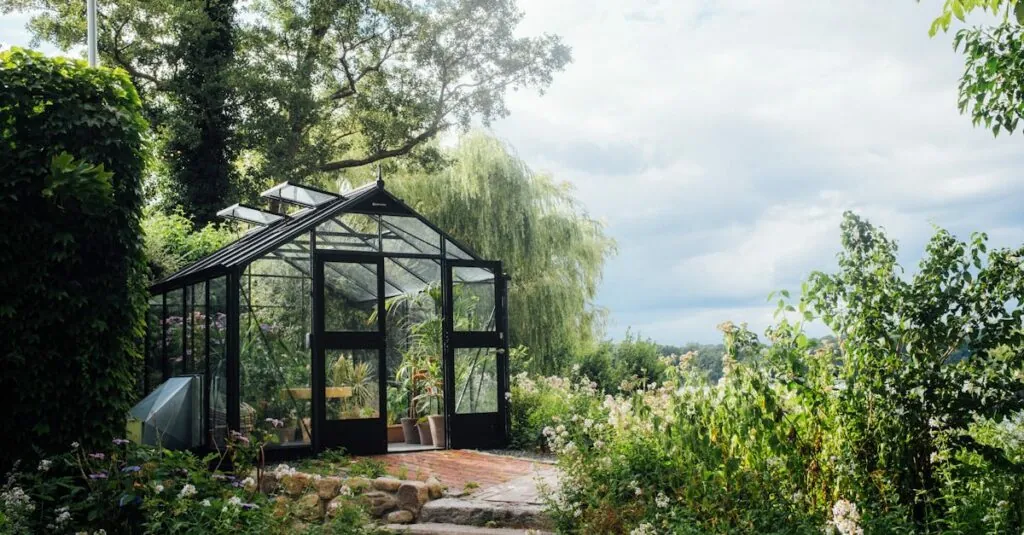Table of Contents
ToggleImagine stepping into your backyard and finding a mini paradise where fresh herbs and vibrant veggies thrive year-round. A backyard greenhouse isn’t just a luxury; it’s a ticket to gardening glory, complete with the ability to grow your favorite plants no matter the season. Who wouldn’t want to channel their inner horticulturist while sipping coffee in the morning sun?
Benefits Of Backyard Greenhouse Installation
Backyard greenhouses provide numerous advantages for gardening enthusiasts. They create an optimal environment for various plants.
Improved Growing Conditions
Temperature regulation plays a crucial role in plant health. Gardeners can control humidity and airflow, leading to healthier crops. Disease prevention increases significantly with controlled conditions. Natural sunlight enhances growth, while protection from pests and harsh weather boosts yields. A backyard greenhouse facilitates year-round cultivation by optimizing light exposure and moisture levels.
Extended Growing Season
Growing seasons expand significantly with a greenhouse. Gardeners can start plants earlier in the spring and continue cultivating into late fall or winter. Improved temperature control allows for the cultivation of heat-loving plants even in cooler months. It becomes possible to grow fresh produce year-round by shielding plants from freezing temperatures. Extended seasons lead to higher harvests and increased variety in crops available for enjoyment.
Planning Your Backyard Greenhouse
Planning your backyard greenhouse involves careful consideration of space, location, and materials. Attention to detail ensures an efficient and productive garden space.
Assessing Space And Location
Space requirements depend on the size of the greenhouse. Evaluating the yard’s dimensions helps determine the optimal greenhouse size. Sunlight access is crucial, as plants need adequate light for growth. Choose a location that receives at least six hours of direct sunlight daily. Avoid areas prone to strong winds or flooding; these conditions can damage the structure. An accessible position enhances convenience for maintenance and harvesting.
Choosing The Right Materials
Material selection impacts durability and insulation. Consider polycarbonate panels for excellent insulation and UV protection. Glass greenhouses offer aesthetic appeal but can be heavier and more fragile. For the frame, aluminum or galvanized steel provide long-lasting strength. Wooden frames might offer a rustic look but require more maintenance. Cost considerations also play a role; budget-friendly options like PVC can be effective for smaller greenhouses. Factor in the climate when selecting materials, ensuring they can withstand local weather conditions efficiently.
Step-By-Step Installation Process
Installing a backyard greenhouse involves several key steps that ensure a successful project. Following a structured approach leads to a durable and efficient structure.
Preparing The Site
Choose a flat area with optimal sunlight. Avoid spots with poor drainage or excessive wind exposure. Clear the ground of debris and vegetation. Measure the space to align with the selected greenhouse dimensions. Leveling the ground enhances stability and allows for accurate alignment of the frame. Mark the perimeter using stakes and string to guide the construction process.
Constructing The Frame
Select the appropriate materials for the frame based on climate and budget. Assemble the base first, ensuring it’s square and securely anchored. Use treated wood or metal piping for the main supports. Connect vertical beams with cross braces for added strength. Incorporate door framing into the design to facilitate easy access. Review each connection for tightness and stability throughout the process.
Installing The Covering
Choose a covering material that suits your climate, such as polycarbonate or glass. Begin by attaching the covering to the frame, starting from one end and working toward the other. Ensure each panel fits snugly to prevent gaps that could let in cold air. Use appropriate fasteners designed for the selected material, ensuring a weather-tight seal. Check for any loose areas after installation and secure them for durability.
Maintenance Tips For Backyard Greenhouses
Maintaining a backyard greenhouse ensures optimal growing conditions for plants. These tips help gardeners keep their space healthy and productive.
Regular Cleaning And Inspection
Regular cleaning promotes a healthy environment. Dust and debris can accumulate on surfaces, hindering light penetration. It’s crucial to inspect frames, panels, and vents at least monthly for cracks or damage. Removing dead leaves and any mold prevents disease spread. Utilizing mild soap and water for cleaning avoids chemical residues on plants. A thorough examination of watering systems ensures efficiency and prevents leaks. Implement a consistent schedule to keep the greenhouse tidy and functional. This proactive approach eliminates potential issues and encourages plant growth.
Managing Temperature And Humidity
Managing temperature and humidity is essential for plant health. Install thermometers and hygrometers to monitor these conditions accurately. Opening vents during hot days allows for airflow and cooling. Shade cloth can reduce excessive heat, protecting sensitive plants. Humidity levels should remain between 40% and 60% for optimal growth. Using a dehumidifier in damp climates prevents fungal diseases. Adjusting watering schedules based on humidity helps avoid overwatering, which can harm plant roots. These steps create a balanced environment for thriving vegetation.
Installing a backyard greenhouse opens up a world of gardening possibilities. It empowers enthusiasts to cultivate a diverse range of plants throughout the year while enjoying the process of nurturing their gardens. With careful planning and the right materials, anyone can create a thriving greenhouse that enhances their gardening experience.
Regular maintenance ensures the greenhouse remains a productive space, allowing for vibrant growth and abundant harvests. By following best practices for installation and care, gardeners can maximize their yield and enjoy the fruits of their labor long into the colder months. A backyard greenhouse isn’t just a structure; it’s an investment in a sustainable and rewarding gardening journey.







